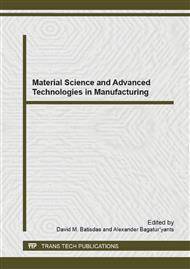[1]
Song Jian, Study on potential carcinogenicity and mechanism of exhaust particles of different size on diesel engine [D],. Shanghai Medical University, (1997).
Google Scholar
[2]
Lu Xiao-Ming, Ge Yun-Shan, Han Xiu-Kun, Wu Si-Jing, Zhu Rong-Fu, He Chao, Experimental Study on Particle Size Distributions of an Engine Fueled with Blends of Biodiesel[J], Environmental Science, 2007, 28(4): 701-705.
Google Scholar
[3]
Lapuerta M, Armas O, Rodríguez-Fernández J, Effect of biodiesel fuels on diesel engine emissions[J], Progress Energy and Combustion Science, 2008, 34(2): 198~223.
DOI: 10.1016/j.pecs.2007.07.001
Google Scholar
[4]
Lin Yuan-Chung,Lee Chia-Fon,Fang Tie- Gang, Characterization of particle size distribution from diesel engines fueled with palm—biodiesel blends and paraffinic fuel blends[J], Atmospheric Environment, 2008, 42(6): 1133~1143.
DOI: 10.1016/j.atmosenv.2007.10.046
Google Scholar
[5]
Krahl J,Munack A,Schröder O, Stein H, Bünger J, Influence of biodiesel and different designed diesel fuels on the exhaust gas emissions and health effects[C], SAE Technical Papers, 2003—01—3199.
DOI: 10.4271/2003-01-3199
Google Scholar
[6]
Casati R, Scheer V, Vogt R, Thorsten B, Measurement of nucleation and soot mode particle emission from a diesel passenger car in real world and laboratory in situ dilution[J],. Atmospheric Environment, 2007, 41(10): 2125-2135.
DOI: 10.1016/j.atmosenv.2006.10.078
Google Scholar
[7]
Moon G, Lee Y, Choi K, Jeong D, Emission characteristics of diesel, gas to liquid, and biodiesel-blended fuels in a diesel engine for passenger cars,. Fuel, 2010, 89(12): 3840-3846.
DOI: 10.1016/j.fuel.2010.07.009
Google Scholar
[8]
Dong Su-Rong, Song Chong-Lin, Zhang Guo-Bin, Pei Yi-Chen, Zhang Tie-Chen, Zhang Bin, Investigation on the Numbers and Size Distributions of In-Cylinder Particulates for a Diesel Engine[J], Transactions Of CSICE, 2008, 26(1): 24-28.
Google Scholar
[9]
Ma Zhi-Hao, Zhang Xiao-Yu, Wang Xin, Xu Bin, Wu Jian, Particulate Emissions of Engine Fuelled with Biodiesel-diesel Blends Using Thermo-gravimetric Analysis[J], Transactions of the Chinese Society for Agricultural Machinery, 2011, 42(9): 26-29.
DOI: 10.1109/iceice.2011.5776943
Google Scholar
[10]
Lou Di-Ming, Hu Wei, Tan Pi-Qiang, Hu Zhi-Yuan, Li Bo, Study on Particulate Size Distribution of Diesel Engine Fueled with Biodiesel under Steady Conditions[J], Chinese Internal Combustion Engine Engineering, 2011, 32(5): 16-22.
Google Scholar
[11]
Tan Pi-Qiang, Hu Zhi-Yuan, Lou Di-Ming, Exhaust Particle Number of Vehicle Diesel Engine during Transient Operating Condition[J], Journal Of Mechanical Engineering, 2012, 48(14) : 134-140.
DOI: 10.3901/jme.2012.14.134
Google Scholar
[12]
Zhao Hui, Zhang Xu-Sheng, Hu Zong-Jie, Wang Hai-Bin, Wu Zhi-Jun, Li LI-Guang Particle Size Distribution of PM Emissions in a China-ⅢDiesel Engine Fueled with Biodiesel[J], Chinese Internal Combustion Engine Engineering, 2009, 30(1) : 23-26.
Google Scholar
[13]
Tan Pi-Qiang, Lou Di-Ming, Hu Zhi-Yuan, Li Bo, The nucleation mode particles emissions on engine with biodiesel blends[C], Chinese society of Engineering Thermophysics, Combustion Science 2009 conference set, 2009 : 1-9.
Google Scholar
[14]
Zhang X S, Zhao H, Hu Z J, Wu Z J, Li L G. Effect of biodiesel on the particle size distribution in the exhaust of common-rail diesel engine and the mechanism of nanoparticle formation. Science In China Series E-Technology Science, 2009, 52(9): 2773—2778.
DOI: 10.1007/s11431-009-0100-x
Google Scholar
[15]
Qiang Q. Study on performance in a China-V Diesel engine. [D]. Shanghai Tongji University,2013:52-67.
Google Scholar


